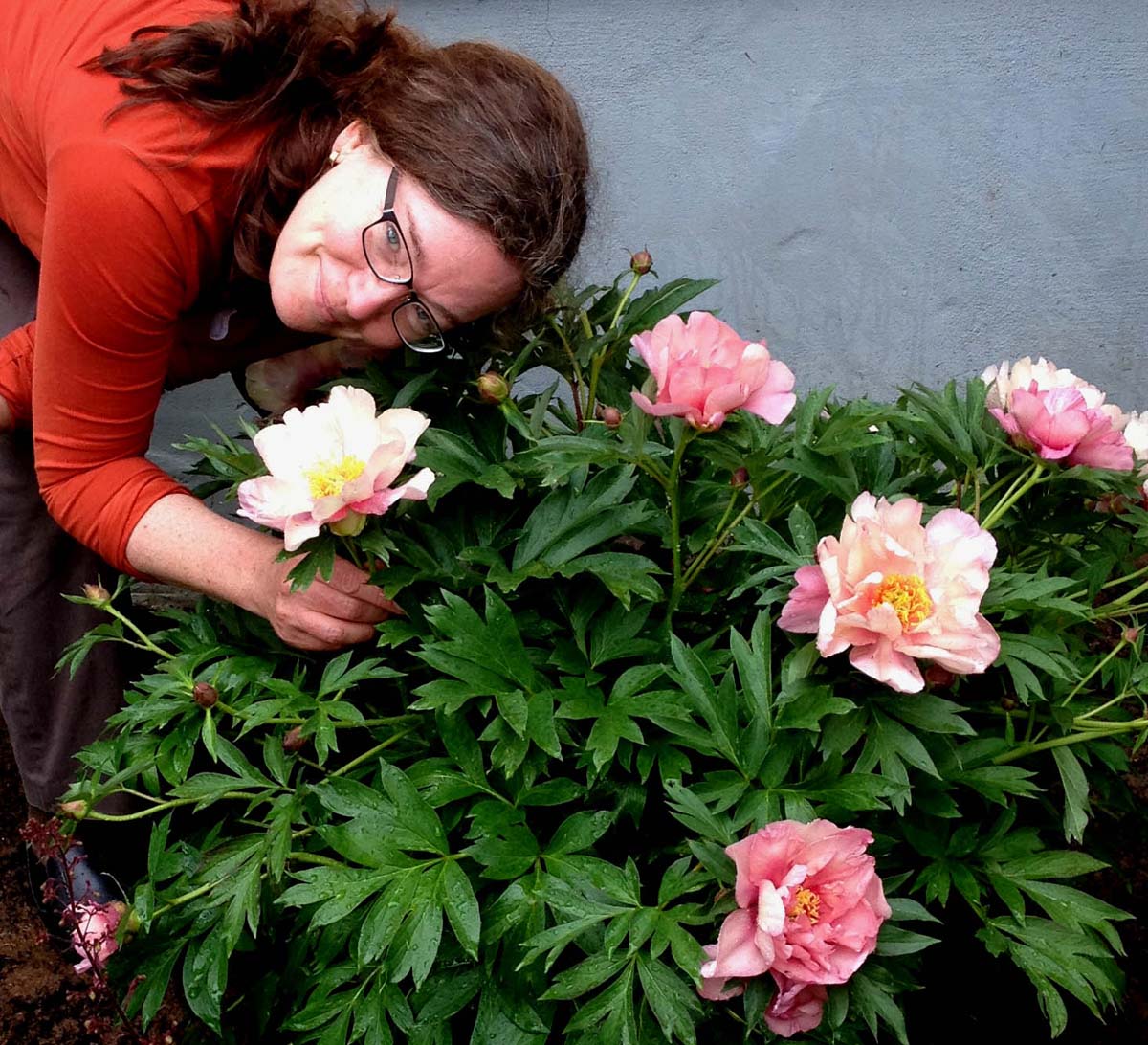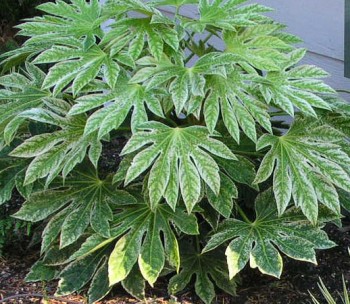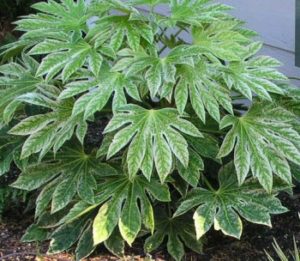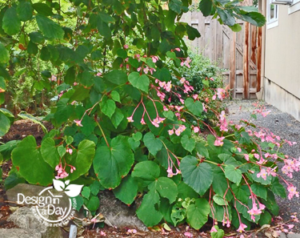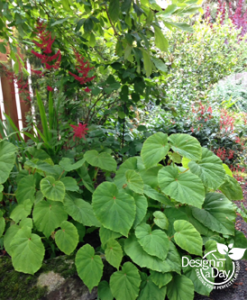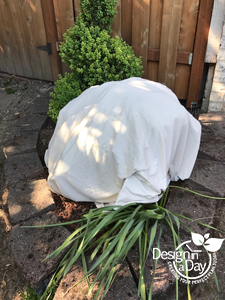Here is a photo of me with Melanie Jane’s (my step daughter) new Itoh Peony. Check out this improved cultivated variety of peony with strong stems and huge rain resistant flowers. Look at the variation of flower petal colors. The newest flower is much darker than the oldest flower. Who can resist such gorgeousness!!! Plus the plant is easy to care for!!!
Archive for May 2012
Deep Shade Plants Tried and True
How to Select Plants for Shade
Let’s look at a handful of plants. Most of these plants can take a little sun but my point is, they can thrive in deep shade which is a difficult area for many homeowners to select plants for.
Selecting Shade Plants
Tip: Think about it…big leaves are like big hands. The more surface area the more light the plants can access. Having said that……this is a perfect example of the rule about how there are no steadfast rules. Our native huckleberry, Vaccinium Ovatum has tiny but highly reflective leaves, (such a rule breaker!) and yet it grows very well in a lot of shade. Sigh…plants are tricky.
Tip: If you have the luxury of planting your mostly shade tolerant plants where they get good dapples of sun of even morning sun they will often tolerant the shade deepening over the years. If your shade is very dark now there are some plants that will eventually thrive but they may take many years to fatten up and fill in. Add one or two very active dogs to this mix and these plants will not survive long enough to do you proud.
Small Trees for Shade
Plant this beautiful Snake Bark Maple under your fir trees….Acer Tegmentosum “Joe Witt” Manchurian Snake Bark Maple
 I have great success with a small tiny leafed evergreen tree called Azara microphylla in deep shade and also partial shade under big fir trees. I saw a tree at an abandoned property in Raleigh Hills where it was providing privacy between neighbors. It had not been irrigated in at least 3 years and was competing with a Douglas fir tree as it was planted about 8′ off the large trunked tree. I’ve been a fan every since and use this small tree large
I have great success with a small tiny leafed evergreen tree called Azara microphylla in deep shade and also partial shade under big fir trees. I saw a tree at an abandoned property in Raleigh Hills where it was providing privacy between neighbors. It had not been irrigated in at least 3 years and was competing with a Douglas fir tree as it was planted about 8′ off the large trunked tree. I’ve been a fan every since and use this small tree large 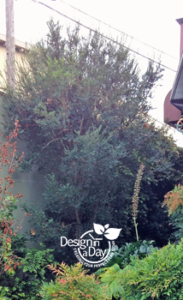 shrub in my city landscapes in N. Portland and N.E. Portland often because it provides privacy but doesn’t get too big. My lousy photo does show the general shape so you can see what a great screen tree it could be.
shrub in my city landscapes in N. Portland and N.E. Portland often because it provides privacy but doesn’t get too big. My lousy photo does show the general shape so you can see what a great screen tree it could be.
Shrubs for Shade
Fatsia Japonica (also called Japanese Aralia) This is beautiful planted as under story to larger trees. It is also my 3 Labrador dog yard plant so very tough and can take a fair amount of morning sun. It can grow to be a 15′ tall tree although it is rare to see it this way. It is easy to prune so can be kept as an evergreen shrubs 3 to 6′ tall or can tolerate deep shade, morning sun or even afternoon dapples of strong light. Tip: Some shade plants can take quite a bit of sun. Many will tip burn the first year or two but go on to tolerate a lot more sun than you might think. Careful watering will make the difference between a guess and a plan.
Aucuba, also called Cast Iron Plant is typically used in deep shade. It has toxic berries so is not a favorite for back yards with dogs although I have seen many old plants grow into small trees and no ones dog has ever bothered to eat the berries. Still who wants to take a chance with their little bundle of joy and I do not trust Labradors among other breeds who seem to think everything should go in their mouth.
Native Plants for Shrubbery
Mahonia Nervosa and Vaccinium Ovatum are both shrubs native to the Northwest. The Mahonia, (also called Oregon Grape) a favorite of hummingbirds, can get a little ratty looking at the end of winter, wait until the hummingbirds have gotten their fill of the flowers and then cut the plant back to about 12″ tall every year. There won’t be berries for birds if you do this but you can keep the plant front yard attractive. You won’t get a lot of flowers in deep shade. I like growing this plant in enough sun to increase flowering for both pollinators and food for birds via the berries. http://www.greatplantpicks.org/plantlists/view/980
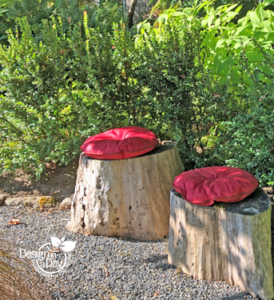 Our evergreen native Vaccinium, a huckleberry plant will be more shade tolerant if you buy it from Boskey Dell Natives and ask for one that was dug out of deep shade. I have self seeded native huckleberry at my home on the Puget Sound in a lot of sun. The truth is the offspring of my plant (little rule breakers) will prefer a sunnier location than if planted in full shade. This is all about natural selection and where your plants seed came from. When I put it on my plant list I don’t require it come from a shade area and it has worked out quite well for my gardens. Please note you won’t get much fruit growing this evergreen in deep shade. My photo is from a tour of the home of Joy Creek Co founder Maurice Horn and his family. He used the huckleberry shrub as a back drop for a casual sitting area.
Our evergreen native Vaccinium, a huckleberry plant will be more shade tolerant if you buy it from Boskey Dell Natives and ask for one that was dug out of deep shade. I have self seeded native huckleberry at my home on the Puget Sound in a lot of sun. The truth is the offspring of my plant (little rule breakers) will prefer a sunnier location than if planted in full shade. This is all about natural selection and where your plants seed came from. When I put it on my plant list I don’t require it come from a shade area and it has worked out quite well for my gardens. Please note you won’t get much fruit growing this evergreen in deep shade. My photo is from a tour of the home of Joy Creek Co founder Maurice Horn and his family. He used the huckleberry shrub as a back drop for a casual sitting area.
Here is a highly textural native fern called Adiantum Aleuticum, Northern Maidenhair Fern. This one has previously escaped my radar. I use a lot of different ferns so nice to have another native one to use.
Ground Cover Plants for Shade
Evergreen plants for shade – Perennials and Groundcovers
These first two are a little more unusual (unless you are a total plant nerd). Beesia Deltophylla, I first met this plant at the famous Heronswood Garden in Kingston, Washington. It is slow to bulk up but is such a low maintenance plant. It would be great to have more access to this plant. When I first wrote this blog in 2012 it was hard to find but now I see it regularly at many retail garden stores. It won’t flower well in deep shade but the glossy leaves reflect light and are a huge asset in a deep shade setting. It will flower in dappled shade and rather nicely.
Begonia grandis – ok this won’t survive the big rowdy dogs but wow it is a cold hardy evergreen perennial with fabulous leaves. The flowers are also attractive. I’m very fond of this plant and have it coming back every year in many gardens. It rooted into a log just under my floating home and lived for several years until a certain someone thought it was a weed and yanked it.
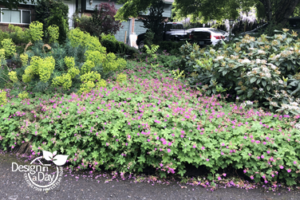 Geranium macrorrhizum is a groundcover shade plant that may take a while to bulk up in deep shade but it will get there. The strong smell of cedar in the leaves tends to keep rowdy dogs out of it so the survival rate is strong but it is not a thug and will slowly clump to cover a lot of soil. It is semi evergreen so you will have some leaves in the winter too.
Geranium macrorrhizum is a groundcover shade plant that may take a while to bulk up in deep shade but it will get there. The strong smell of cedar in the leaves tends to keep rowdy dogs out of it so the survival rate is strong but it is not a thug and will slowly clump to cover a lot of soil. It is semi evergreen so you will have some leaves in the winter too.
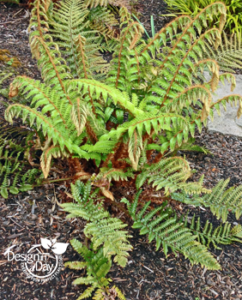 The best fern for deep shade is our native Sword fern, Polystichum munitum but another option for shade is this non native often called Shield fern. It will take a lot longer to establish than our good old Sword. Sword fern can also handle a lot of doggie rowdiness , (even in shade) if you start with a nice big plant. I’m feeling unfair to other ferns because I always talk about Sword Fern and how fabulous it is.
The best fern for deep shade is our native Sword fern, Polystichum munitum but another option for shade is this non native often called Shield fern. It will take a lot longer to establish than our good old Sword. Sword fern can also handle a lot of doggie rowdiness , (even in shade) if you start with a nice big plant. I’m feeling unfair to other ferns because I always talk about Sword Fern and how fabulous it is.
We would love to help you with your shady landscape. Contact us if you are ready for help with your difficult shady and probably muddy back yard.
Hydrangea Love
There are several lessons in this story for you, O gentle reader………..how to successfully transplant a shrub or tree in July heat……, how to prevent hot weather damage to your plants when we have intense hot weather right on top of weeks of cool rain, (more critical if you agreed to have your garden on a fundraiser tour). This will also work to restore plants in a container that you forgot to water???? ……………..these helpful lessons all fit into this story.
The story: My mom and dad planted and named the two hydrangea by the back patio, Mary and Oliver. Mary was beautiful no matter what but Oliver had troubles. Every year in early summer, Oliver’s flowers would get crisped. If they had planted Oliver a few feet closer to the covered patio there would be no problem and no story. They planted Mary in the afternoon shade of the patio but Oliver got the early afternoon sun in June and July. He was just not a super sun tolerant kind of guy.
He could handle the sun better once the leaves and petals had hardened off in July but in early June, while the leaves and petals were full of spring, freshly unfurled, a 100 degree day or two would toast all the new flowers on the plant. So Oliver’s flowers would scorch and my parents would then over water Oliver trying to get some water back into his petals. They did not understand that once petals are scorched they stay that way. Oliver’s new flowers were fine but now the plant’s leaves looked terrible. Over watering caused the leaves to wilt and yellow. Oliver was a mess. I offered to come over and protect Oliver from them. The human Mary and Oliver had long since gone on so these were not really plants to my parents, but symbols of their dear friends.
So how did I do this? The Sheet Trick! My first solution was to water once a week and the second solution was to protect Oliver from intense sun. My solution was time consuming mostly because I lived in NW Portland and my parents lived in Gladstone. If I was expecting intense sun, I would drive over, get out some binder clips, drape a white sheet over Oliver to cover all his leaves and flowers and then clip the sheet onto various large stems so it could not blow off.
Because the leaves were covered (this is science folks!) they held in the water rather than letting it go, this is called transpiration. Transpiration is part of the plants photosynthesis process with the sun. See Wikipedia on photosynthesis. Since the flower petals and leaves kept their water, they stayed cool enough and did not scorch. I would not leave the sheet on for more three days at a time so I didn’t have to go over there every single day, just when I knew it was going to be hot.
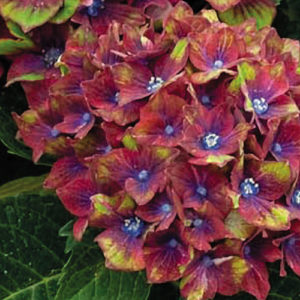 What’s important for you gentle reader is that this sheet trick is handy beyond belief for all kinds of things. Number 1 best tip ever for transplanting a shrub in the summer…….keep it covered for 3 days and I mean immediately or even during the digging of the plant if you are feeling compulsive. Use it to protect flowering plants if we have intense heat while the flower petals are still new and soft. Use this trick if you have had an irrigation boo boo and your plants in one area didn’t get any water and have wilted. Presto, sprinkle the leaves with water gently, water the plant and cover for a few days……..your plant will have a better chance of recovery.
What’s important for you gentle reader is that this sheet trick is handy beyond belief for all kinds of things. Number 1 best tip ever for transplanting a shrub in the summer…….keep it covered for 3 days and I mean immediately or even during the digging of the plant if you are feeling compulsive. Use it to protect flowering plants if we have intense heat while the flower petals are still new and soft. Use this trick if you have had an irrigation boo boo and your plants in one area didn’t get any water and have wilted. Presto, sprinkle the leaves with water gently, water the plant and cover for a few days……..your plant will have a better chance of recovery.
Every generation loves hydrangeas, my parents loved theirs, I love them although confess I have none of my own down here on the floating river house, my step daughters would love to have them…..maybe I can fix that this year. They also look mighty fine with ornamental grasses so not just for an old fashioned garden but could be used in more modern gardens if placed thoughtfully.
Categories
- Accessory Dwelling Unit ADU
- Before and Afters
- Customer Testimonials
- Deck Design
- Design Basics
- Designers Journal
- Dog and Cat Friendly Gardens
- Dramatic Flowers
- Dramatic Flowers
- Drought Tolerant Garden
- Easy Edibles
- Fall Gardening
- garage design
- Garden Pests
- Garden Tips
- Gardening Green
- Landscape Styles
- Low Maintenance Landscape Examples
- New Improved Plants
- No lawn back yard
- No Lawn Front Yards
- outdoor living
- Parking Strips
- Plants I Recommend
- Privacy
- Rain Garden
- Seasonal Event
- Shade Garden Tips
- Shade Plants
- Spring Gardening
- Summer Garden Tips
- Synthetic Lawn and Dogs
- Tree Selection
- Water features
- Winter Gardening
Let’s make your landscape beautiful.
Get these easy and simple tips on how to keep your garden, patio, or other outdoor entertaining places beautiful. You’ll also receive my monthly newsletter and stay up to date on: design ideas, dog friendly designs, native plants, nurseries we love, upcoming garden events and tours.
What we offer
How to contact us
- 503-223-2426
- Email us on our contact page
- Landscape Design In A Day
- 1511 SW Park Ave #710
- Portland, OR 97201
Recent blog posts
- Designing a Charming Outdoor Living Space in Overlook Neighborhood for 20 Guests: Part One
- Custom Irvington Neighborhood Landscape Sees New Life With New Owners
- Update on Back Yard Design for Irvington Neighborhood Baby Boomers – Part 2
- From Wasted Space to Outdoor Oasis: Grant Park Custom Landscape Design Part 2

